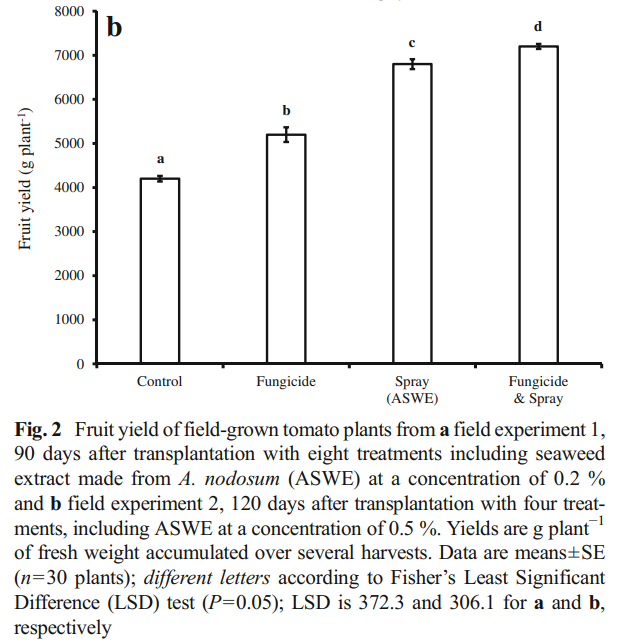The effect of Seaweed/Kelp extracts in plants
Few bio-stimulants are more popularly used than seaweed/kelp extracts. These are used by many growers to increase plant quality and yields, in particular, extracts from the Ascophyllum nodosum species are an all-time favorite of the industry. These extract have also been studied extensively for the past 40 years, with large amounts of evidence gathered about their effects and properties across several different plant species. In this article, I will be talking about what the research says about their use, why these extracts work, how these have usually been applied and what you should be looking for when using this type of bio-stimulant.

The use of kelp extracts is so common, that there was already enough research done about their use to publish a review on the subject in 1991 (1), a lot of the information below comes from this source. Seaweed has been used by farmers for hundreds of years, as it could be used as an alternative to lime in order to alkalinize acidic peatmoss soils, due to the high basicity of seaweed extracts (as some are very high in calcium carbonate content). Seaweed extracts also contain a lot of micro and macro nutrients – as shown above – in proportions that are useful for their use as fertilizer. They are a significant source of potassium and calcium, although the variability of the composition – as shown in the table above – can be quite important. They also contain micronutrients but their low presence relative to plant needs implies that the positive effects of the extracts are most likely not due to them.
Perhaps one of the most important factors surrounding seaweeds is their content of bioactive molecules. These extracts contain an important array of cytokinins, which are plant hormones that will significantly affect plant growth. Auxins, gibberillin-like substances and ethylene precursors like aminocyclopropanecarboxylic acid, have also been detected in seaweed extracts. The cytokinins are usually present in concentrations of around 2-20 ppm in the concentrated extracts, which are enough to cause effects, even if the final diluted versions will be at much lower concentrations. The application of seaweed extracts is usually done through an entire crop cycle and is usually cumulative in nature.
Application rate, frequency, seaweed species and extract processing methods can substantially affect results, with many contradictory results showing up in the literature, with some people showing increases in growth and yields while others show no effects at all. The review quoted above describes many examples of positive results, including examples showing weight gains, yield gains and increases in certain nutrients, like P and N. The review also talks about the ability of seaweed extracts to increase resistance to pests and improve crop quality. A more recent review from 2014 (2) further expands on a lot of these positive effects, citing extensive literature showing increases in yields, dry weights and quality for a wide variety of plant species. In total, more than 30 different papers showing increases in yields due to the use of kelp extracts are cited in this review. There are also more than 20 articles cited describing increases in disease resistance or other mechanisms of defense elicitation due to the use of the seaweed extracts.

Foliar applications of seaweed can be carried out at varied levels of frequency and concentration. Applications at a 0.2-0.5% w/v of dry extracts are most common, although higher or lower concentrations have also been found to be effective. As a root drench applications will tend to be on the lower side, as the seaweed contains a substantial amount of NaCl, which can be damaging to plants. Timing of applications can also be quite critical, some growers apply the extract equally spaced through the entire growing periods, while others attempt to time the application with a specific growth phase. Success is reported in both cases, although papers that describe different timing of single applications often find significant differences. To arrive at the optimal usage for a plant species it will be necessary to carry out tests with single applications at different intervals, although single weekly applications are likely to be successful if a less involved approach is desired.
Although the use of seaweed extracts can be very positive, it is also worth mentioning that it is very dependent on the quality and consistency of the extract being produced. Since we know that most of the positive effects of these seaweeds are related to their plant hormone content, their use can sometimes be replaced with specific applications of plant hormones, if the effects are properly understood. The discussion in (2) cited before points to the fact that kinetin applications have been able to match the effects of kelp extracts, at a fraction of the cost and the environmental impact at least in a few cases.

With all the above said, it is quite evident that kelp/seaweed extracts have been widely confirmed to have positive effects in the growing of plants, beyond any reasonable doubt. This effect is mostly related with the hormones they contain and is therefore dependent on the seaweed species, where it is grown and how the seaweed powder is generated. Although root and foliar applications of kelp can both be used to improve results, the use of foliar applications is often favored in order to avoid the introduction of some undesired ions into the growing media. If you’re not using kelp, go ahead, it’s bound to help!